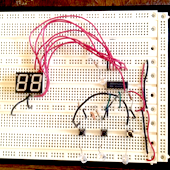
Since I’m new to electronics I thought I would document some of my successful experiments. Both so others can learn from my progress and so I can have a reference to revisit in the future in case I run into problems. I have an idea for an Arduino project that will require more I/O than the UNO is capable of. I learned that shift registers are a great way to expand the number of Inputs or Outputs you can handle, up to eight at a time. The way they work is pretty straight forward. In the case of shift-out registers, you simply push a pattern of HIGHs or LOWSs onto a stack internally on the IC. When you make the latch-pin HIGH, everything you pushed in serially will be converted to paralell outputs. That is, 8 of the pins on the shift register will go HIGH or LOW depending on the serial pattern you input. Shift-In registers work similarly in reverse, allowing you to read the state of 8 pins on the IC all at once, then stream their values in one at a time serially to the Arduino. The advantage of this is that you can have up to 8 inputs or outputs, while only using 3 pins on the Arduino. But what’s even more impressive is that you can daisy chain these ICs back to back. If you use 2 74LS595 shift-registerts back to back, you can have SIXTEEN outputs, while still only using three pins! In fact, you could use four 74LS595s in a row and have 32 outputs and still only 3 pins on the Arduino. Handy!
While I thought this would be an easy build, I ran into lots of problems, mostly having to do with floating values. After figuring out that I needed some pull-down registers I got everything working. Check the video below for the build:
July 23, 2014 at 10:17 pm | Video